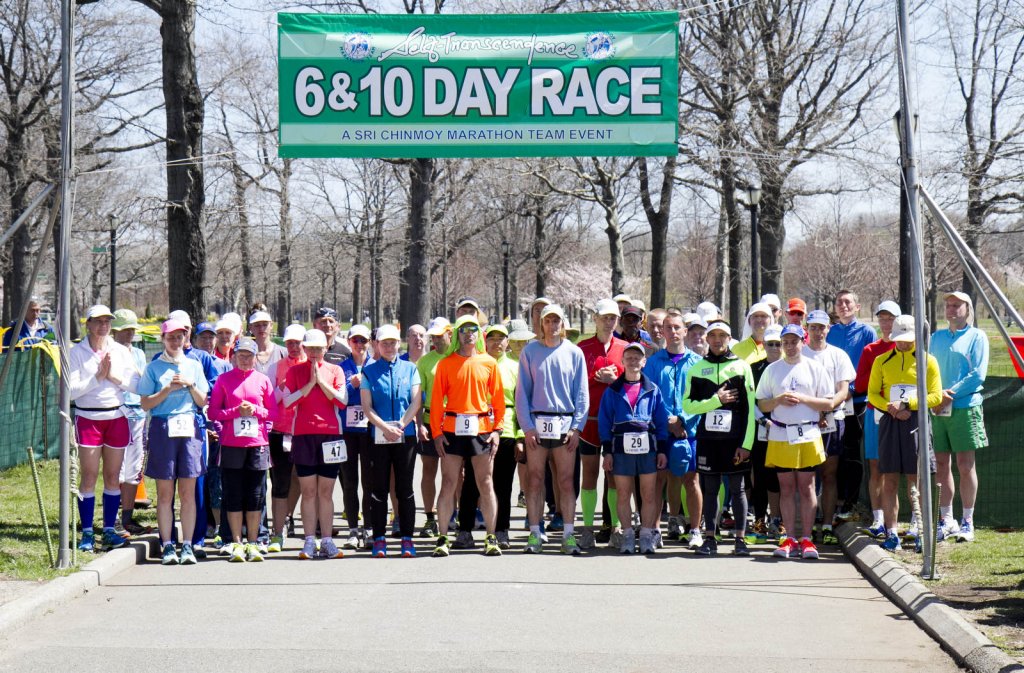Mind tricks for dealing with the relentless distances in multi-day races.
Part 1
It’s day five of the Self-Transcendence Ten-day race in Flushing Meadows, New York. I’m not actually there. Well, I was there but now I’m going through voice recordings I made during the race to see if there is anything of interest.1 I found that each day I’d get what seemed to be insights and, in a sense, solutions to the difficulties the race was triggering and felt the urge to note them down before they disappeared. Despite being immersed in the race at that time, there was still a feeling of stepping back and observing oneself. Going through the recordings is yet another retreating back and in fact now writing about bits and pieces in the transcripts continues that regression 2
This starts with a bit of a digression but I’m keeping it in an attempt to give a very rough idea of the race. For the technique skip ahead to part 2. .
Looking through the transcripts, one thing has cropped up which I now realise was key to being able to finish. In order to cope with the endless time and distance in ultras, one has to come up with ways to trick the mind. Part of the fascination of these long-distance challenges is seeing how, with the right approach, you can gently shake the tree of impossibility and achieve far more than you ever imagined possible. Meditation has been pivotal in helping me find ways to do this and was undoubtedly what kindled my interest in participating in the first place.

Some of the excerpts do sound like the ramblings of someone high on endorphins and the sheer exhilaration of the event, but I find a few interesting sections. States of exhaustion and changed awareness often mean that simple things, like the night sky or the lights of the planes coming into land, become extraordinarily beautiful and meaningful. During the day I tried to remember key ideas and later recorded them whilst walking a lap or two at night, when people wouldn’t be able to hear. One significant thing was a trick I had been using to get through the large number of laps each day to achieve my goal. Although this now seems bizarre looking back, at the time it had a strong effect on me and the whole race hinged on it. Thinking about it now is something like waking in the morning to find that, in the light of day, the mundane surroundings of our room, which took on all sorts of shapes and meanings in the dark, are now just bits of furniture or items of clothing lying around. That’s probably why I had forgotten all about it.
The course has changed this year due to some engineering work on the footpaths. I loved the old loop and when I heard it was to be different there was a sense of panic as you get very attached to a loop you have been around thousands of times. The fear proved to be unfounded as the new loop incorporated much of the old and was even better. By lunchtime on the first day it was already my new favourite loop. 3
The course meanders through the park and despite its urban setting feels quite wild in places. It feels very exposed to the elements, with a frequent chilly breeze blowing in from the Hudson river on one side and from the sea on the other. Runners often bake on one side and then freeze going down the straight by the lake on the other side, resulting in frequent changes of clothing even on the same loop. For me this was always the single hardest thing to deal with.
Freeways and bridges sprawl around the perimeter and even in the middle of the night there is a continual roar of traffic in the distance. At night trucks thunder along the old, potholed highways and where the surface is uneven you hear their suspension crashing down onto the iron supports on the surface of the road.
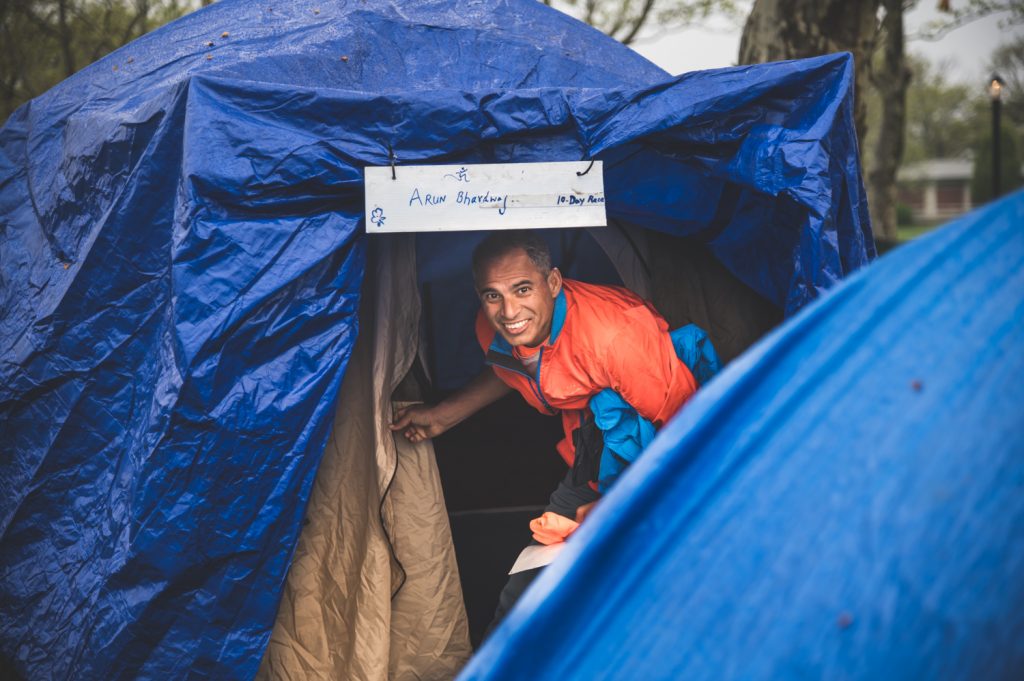
Overhead, planes come in from different directions throughout the day as they descend into nearby La Guardia airport. Everything is suffused with a dynamic energy and a kind of restless, meaningless chaos, yet there is often a deep sense of peace and beauty out on the course. The afternoon breeze can stir up the surface of the lake making small white crests form and the ever-changing light conditions make each loop a different experience. Rain can appear quickly, flooding the course, and creating all sorts of reflections in the puddles, only for the skies quickly to clear again revealing puffy white clouds mounting up over Queens. Then the glare of sunlight on the wet paths fades again and within hours there can be a heavy grey mist. Often the April race coincides with the arrival of the spring blossom. You yearn to stop and merge with the exquisite beauty, dreaming of being whisked away into that world or the quiet of home again, but the momentum and sheer necessity to keep toughing it out means you can never really stop or even let the mind wander too far off like that. 4
Everything is run down and slightly neglected looking; the pathways are full of potholes and the tarmac is uneven, puckered and cracked in places. Where the loop skirts the perimeter of the park, all that separates you from the river of traffic is a flimsy wire fence, often broken in places and full of holes. Sometimes you see families staking out a claim to a bit of verge just inside the fence, enjoying their weekend barbecue right there beside the deafening roar of traffic, rather than venturing a little inside the park.
Large rusting green signs hang off the bridges and walkways over the neigbouring roads giving directions: Long Island Expressway, Van Wyck, Harry Van Arsdale Jr Ave, College Pt Blvd Exit 22E.5 Meaningless really when you are in the park but some part of the brain seems to read them and then forget all the details hundreds of times over.
It’s all unkempt and run to seed, yet there is a special feeling or charm underneath it all – freedom and possibility, and perhaps modernity in that sixties or seventies sense rather than that of today’s information technology and fibre optic broadband sense. On misty days it’s Brooklyn bridge and Sonny Rollins playing the sax underneath it with hints of the jazzy chords of Gershwin and Bernstein in the traffic sounds. Perhaps from an earlier era altogether it’s Gatsby speeding past in his sports car, full of life, hope and vibrance. There is always such a diversity of people in the park; joggers, dog walkers, park attendants and people down on their luck trying to make sense of it all.
The race is a dynamo that seamlessly blends in with it all, or a vortex slowly gathering more and more momentum. The energy builds day by day as cooks, helpers, spectators and counters go about their tasks and the runners spin around the eternal loop. Then at weekends the race disappears into the background as the park fills with hundreds of visitors. Indian cricket teams come and practice batting and bowling on the paths used by the race, Dominican groups have football matches and then move on to large extended family barbecues with cheap plastic tents and trestle tables laden with food.
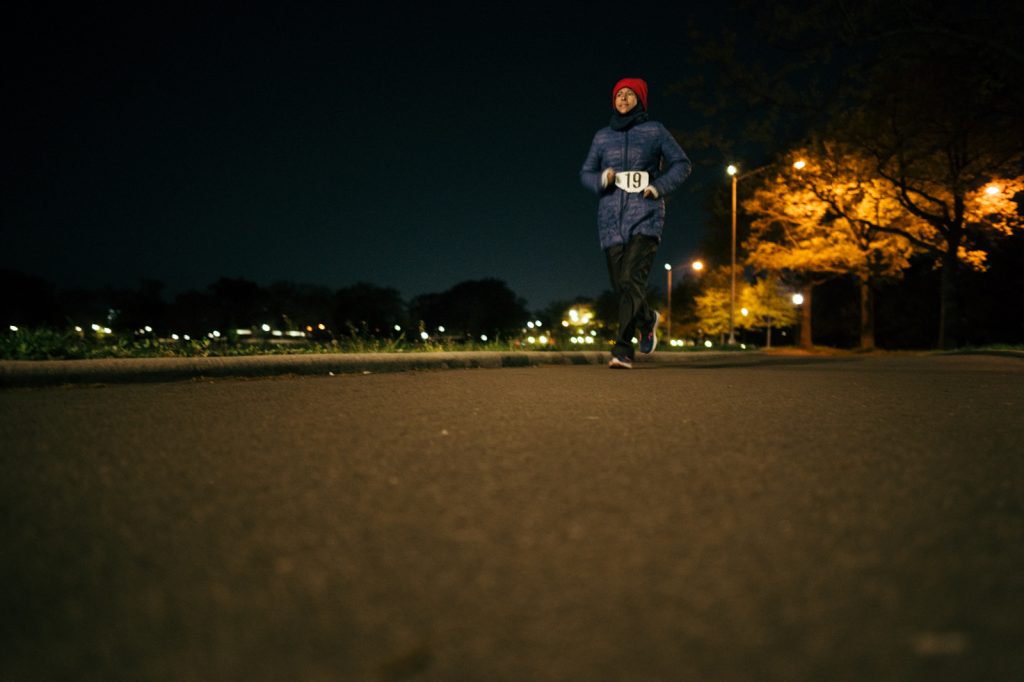
The smell of burning meat fills the air as runners try to weave through the chaos of it all. Then the Passover festival brings droves of Orthodox Jews out dressed in all sorts of beautiful costumes. They wait in long lines, some of the men standing out in their enormous furry Shtreimel hats, waiting to hire pedalos to take out on the lake. Others hire bicycle chariots and bomb around the paths on them narrowly missing runners’ ankles and feet. Nobody notices the rather unusual running race ticking along in the background, though presumably sometimes people must wonder who these people are, with number bibs on their t-shirts, shuffling along in their tired and eccentric ways.6 Often it feels like you are floating along in some kind of alternate reality that intersects with the normal world and perhaps nobody can see you anymore.
There is a kind of base camp in one part of the park, where everyone has a tent or a place in a so-called dormitory, basically a small marquee erected for the duration of the race with some camp beds in it. There is a large tent that serves as a kitchen, another one for the teams of lap counters, one for helpers and a medical one, where people go to get patched up, massaged and feel sorry for themselves before braving the battlefield again.7 Most runners sleep and rest in makeshift tents they erect the day before the race. These sometimes get blown away or runners find all their gear drenched after a flood, further adding to the challenges of the race! The whole place is suffused with a mad euphoria of energy and there never seems to be any sign of a depressing moment in those involved. That must be part of the draw to be involved or to keep participating year after year despite the intense physical discomfort, exhaustion and repeated promises to oneself never to repeat it.
Part 2
For day five I’m quite pleased with progress but there is no stopping for another six days.8 I’ve covered 220 miles and am just ahead of my 50 miles a day minimum which I need in order to reach 500 miles. The loop is 0.8 of a mile, so I know I have to do 63 laps daily. I also know for a fact that I have to find a way to persuade my mind otherwise, to stop it from rebelling and probably scuppering all hopes of finishing as planned.
Everyone, from first-timer to seasoned multi-day runner, starts these races with enthusiastic schedules for how to manage the time and distance, and in fact you have to have some kind of plan. But most more experienced runners know that whatever ideas you have will be shattered within hours of starting. It’s the nature of the beast. You cannot start without a plan and you also know that it will fall apart quite quickly. There’s also no way of fooling the race gremlins by your strategy being to pretend to have a plan that you know will not work because that’s also just another plan in itself and it will also fail!
There are infinite ways to divide up the day; factoring in time for rest, food and attending to other myriad details. Once it occurred to me that to get to fifty miles a day I could just run a mile every half hour. Whatever time remained would be ample rest. So I could run two miles and then have the remainder of each hour free, and so on. To the mind that seems like a doddle – a walk in the park perhaps. Another time in the middle of a race, a fellow competitor came past me and said he had the perfect schedule for me. It involved running for four hours only and then taking an hour’s break. After four sets of that, you could then get four hours of sleep overnight. What could be any easier than that?9 In fact at 15 min pace per mile the four sets would give you sixty four miles and you could get 8 hours off! I didn’t make it through the first four hours! This really only works for the elite runners. It would be fine for day 1 but by the second day it is always much harder than you can imagine.
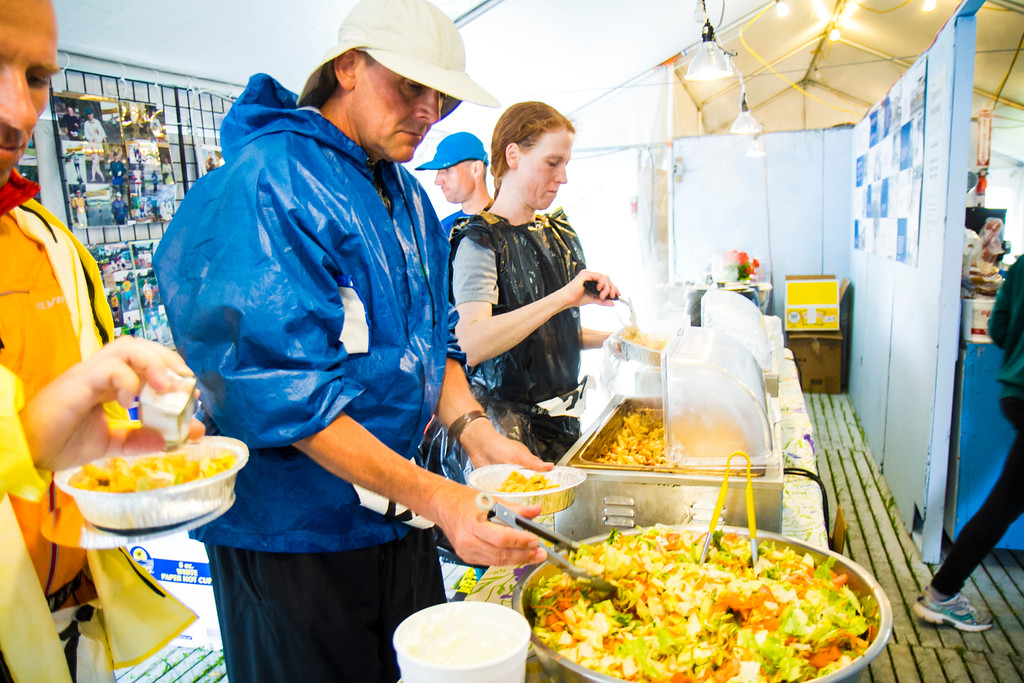
What finally started to work for me was to divide the 63 laps I needed into three sets of 21 laps, one set for the morning, afternoon and evening respectively. I wouldn’t let myself go to the tent for the night until I had reached the required fifty miles. This worked for the first two days but very quickly the days started extending beyond midnight and I wasn’t turning in until one or two in the morning.
That’s tough as of course you have to be back out no later than six to repeat the whole process the following morning, starting back at zero miles. In fact each day it got later and later until by the end there was no night’s rest at all. I’d see people coming back to start their new day when I was still finishing the previous day’s mileage.
By the third day, the evening sessions of twenty-one miles were becoming too hard and it was also making the afternoon harder as I knew that, once those miles were done, I would have another huge set to complete in the dark and cold.
The evening was when I was at my lowest ebb – if only magically it were possible to do some of the evening laps during the afternoon when there was more energy. And that’s precisely what I started doing.
I’d get the morning laps under my belt, take a short lunch break, and then start on the afternoon ones in the normal way. Once I had got a certain number done which didn’t leave too daunting a portion of the afternoon set of twenty-one remaining, after seven to ten loops say, then I’d put the afternoon set on hold and start knocking off the evening ones. I’d focus quite intensely on them treating them as if they were the harder night-time ones, and really throw myself body and soul into the feeling of those laps. Once I’d got those down to a manageable number, say having eleven to thirteen remaining from the evening set, then I’d go back to my afternoon set and finish those ones off, knowing in the back of my mind that there would be less to do in the evening.
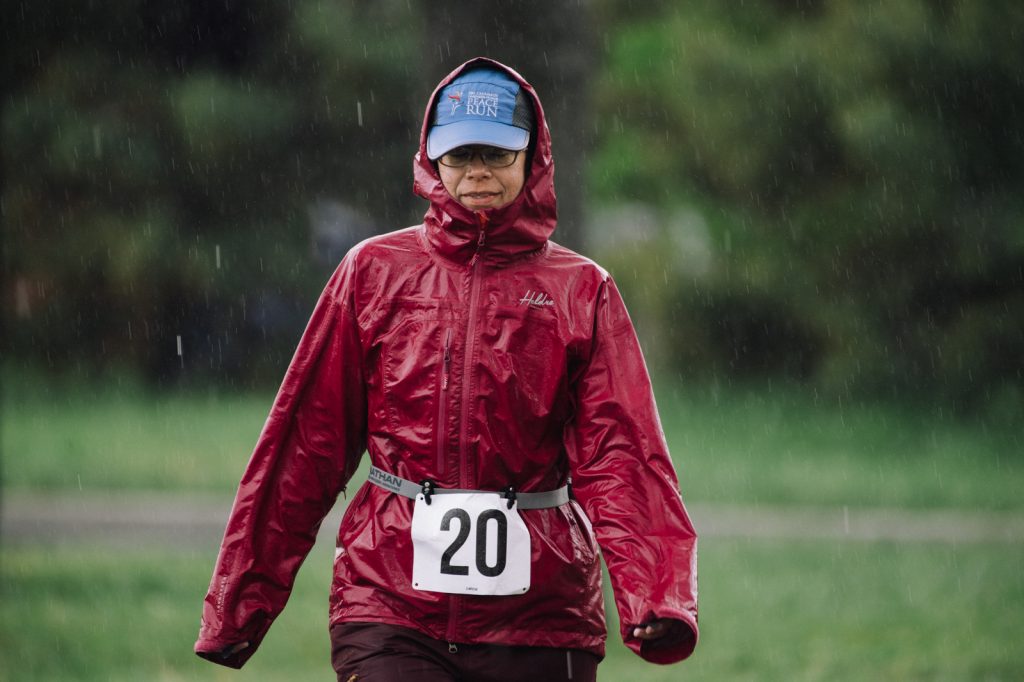
From a mental perspective the remaining afternoon set was manageable. Already there wasn’t that nagging fear of the long evening laps to follow as they were now less. When totally exhausted late in the evening, instead of fear and dread at the prospect of 18 more miles before being able to enjoy the luxury of a warm sleeping bag and blissful sleep, a slight thrill would appear that there was a manageable amount left (and of course from a feeling of joy comes energy, whereas from dread comes tiredness). I knew that once the remaining afternoon laps were sorted then in the evening, after a few laps, there would only be 10 left and of course those were laps and not miles (so less) and very soon it would be 9 and the end was a possibility (mind games have to be played at every moment).
These techniques have a kind of fractal element to them too. So, for example, faced with those remaining 9 laps, which will still be a struggle (though now hopefully mentally a tiny bit less of one), one can apply the same technique. For the sake of illustration assuming those final laps are going to take 3 hours, then focus on the final set of 3 laps and the last hour first and get that done or at least 2 of them. Then come back to the first set of 3 laps.
It just requires considerable mental effort to be put into maintaining the facade, rather like a simple magician’s trick that on the surface looks incredible but relies on some very simple deception or distraction. It’s as if more energy is being channeled into this than perhaps into the actual physical effort. At this point if the mind powerfully intrudes and one is sceptical then it would be easy to say that it’s all very well but you have lost the time in bringing the evening laps forward. From a mental perspective this is undoubtedly true but, if you believe the fabrication enough, the energy that you gain from it can very slowly and quite dramatically override the stark reality of the time lost. The parts of the brain that you have to engage to dip into this seem to be happy with a less rigid experience of the passage of time and allow for a more subjective one.
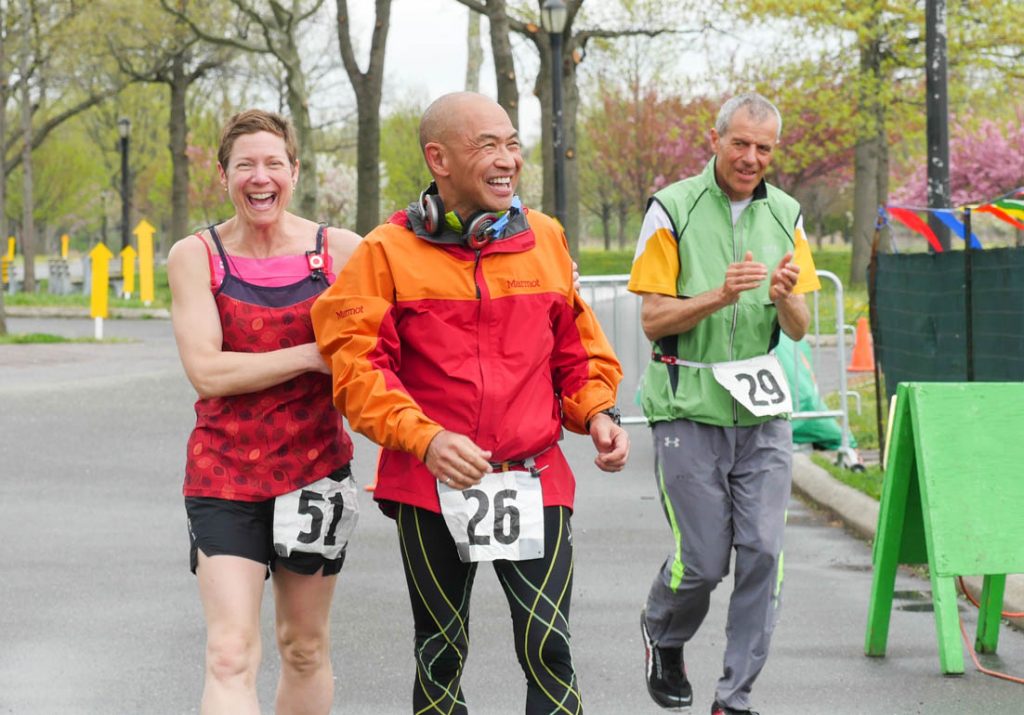
From early in the race a slight dissociation from one’s surroundings starts to creep in without you really realising it. This state probably helps you to imagine you are really doing a different lap from the one you are actually on.10 What starts off as a kind of fun visualisation becomes more real and crucial than you might expect. It’s as if in your state of mild exhaustion and with a fair bit of willpower and allowing that this just may be possible, you really bring these things into being.
In addition to fooling with the laps in this way, because of the inexact length of the loop, in my mind there was always a slight confusion over exactly how far 21 laps was in miles. It’s a very easy calculation but just enough of a calculation that you have a chance to stop your mind from performing it. And that is precisely what we want to do – curb the mind’s ability to think what it wants without us being able to control it. Although it’s probably virtually impossible to stop your mind ‘thinking’ of a single word or very basic thing, as soon as there are some steps involved to get from one idea to another, then you have some chance of stopping it from happening.
If the loop had been one mile exactly then it’s so much right there in your face that you have no chance of avoiding looking at it. When you are tired, it takes some mental effort to work out what 0.8 multiplied by 317 is (in fact even when you are not tired!). I give that as an example as realistically you might come through the counters’ area and they would reel this off their sheet. So they have told you your total laps but you don’t know what that is in miles without having to make quite an effort.
Of course you can come up with a very good rough approximation just by quickly visualising the numbers, but it seems that is a slightly different part of the mind which isn’t such a hindrance to our progress. As long as the stark reality of how far we have covered is not right there in front of the mind’s eye, then it becomes easier to fool it. Although the mind can act like a petty disciplinarian in the background, it doesn’t take too much effort to fool it. We can become adept snake oil salesman in our dealings with the mind.
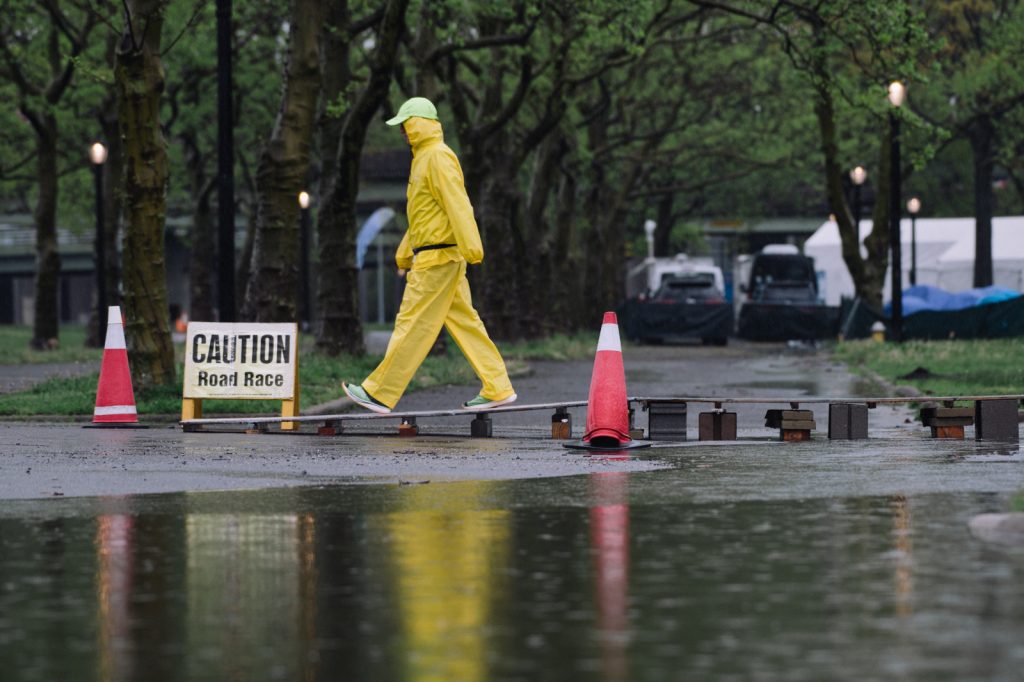
So for the rest of the race an elaborate deception is set up to stop the mind from finding out the full truth. By the exertion of some willpower, the surface analytical mind is kept in a continual state of mild confusion, enough to keep out the really destructive thoughts and to allow for the seeds of hope (maybe, just maybe this distance can be completed…) to be sown. The mind probably does know exactly what is happening on some level, but it’s a part of the mind that is perhaps not so destructive.
I wonder if it’s similar to children playing games. Evidence implies they do seem to know that it’s a game underneath but at the same time they can fully immerse themselves in it in a way that adults generally cannot. Also at that age the analytical categorising part of the brain is not quite so much to the fore.11 A continual trickle of physical and mental energy is required to keep the farce going, but it’s a worthwhile and necessary investment of our time. It’s also something, crucially, I believe we need to train alongside our normal workouts. In fact just as there is a move to improve physically each time we train, so there can be a slow strengthening of this part of the mind.
Each time you finish a lap, there is a group of lap counters that clocks you and calls out your total. When I was doing my evening laps internally during the afternoon as I’ve been explaining, sometimes I’d be about to correct the counters, as in my mind I was further ahead. Of course I realised that as far as they were concerned it was just any old lap. This state of mind, for example imagining that you are running at night but monitoring what is going on around you in the afternoon, may come about more when your mind is deeply focused.
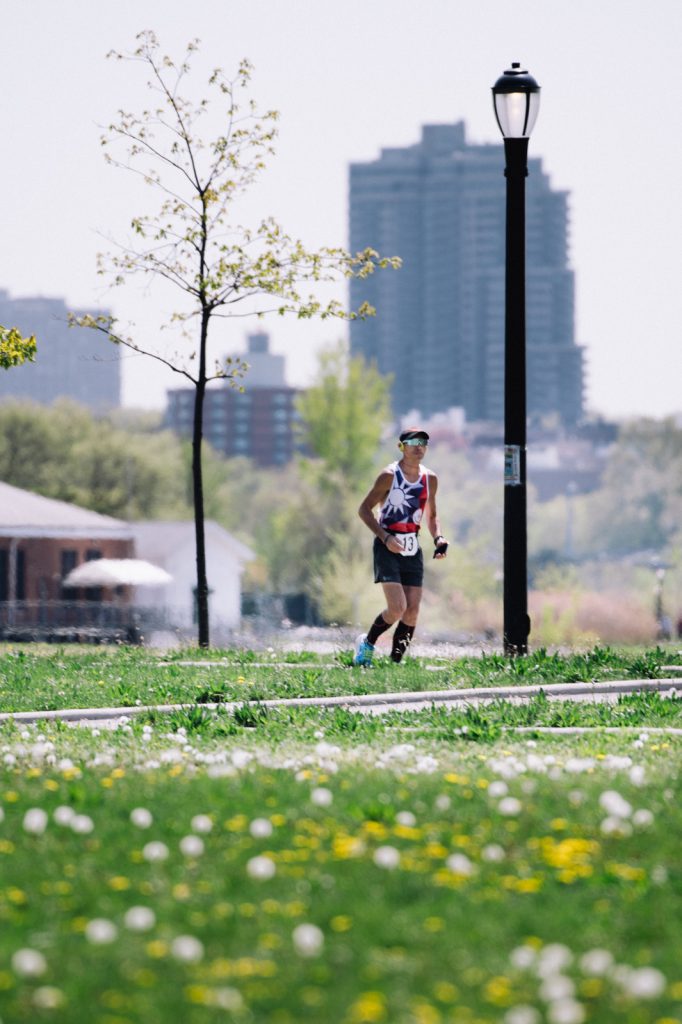
We’ve all had the experience of being lost in a film or book and finding ourselves almost oblivious to the more mundane happenings around us.
With effort and some element of creativity, imagination and perhaps play, it does seem possible not to think certain kinds of thoughts, particularly those that are either destructive or will just drain our energy giving us no help. It’s more than just an on/off switch that will magically be available on the day of the event as it will take some setting up and practice. Ultimately I think it’s what the training is really all about: it’s about practising finding this beneficial mental state and having it ready to conjure up during the race. The training is far less about the physical than we think. In an ideal world perhaps you could just train this mental part but it seems most of us can only get to it through the physical training. Perhaps the take-home is that during the physical training we can be consciously working hard at preparing ourselves mentally, something that most of us tend not to do.
If we can calm the restless mind, open up the heart and slowly investigate deeper parts of our awareness, it might be that we merge and identify more with what is happening outwardly, for example with the loops, and find that each one has its own kind of uniqueness. From the perspective of the analytical mind that loves to categorise, each loop is the same, but from the more experiential part of our being, each loop may have its own unique reality. The evening loops are qualitatively different from the afternoon and morning ones, which is why we can identify with them and pull them out of their normal temporal location into our subjective afternoon time.
Very quickly once the race ends, everything is cleared out and there is not a single trace left of the swirl of activity that descended there for almost two weeks. One drizzly afternoon at another time of the year I went back to visit the park. The little hill out of the camp leading to the first turn into the carpark had disappeared – it was pretty much a flat stretch of road. During the race every runner will tell you that it is quite a significant little incline! All that remained was a broken, lifeless children’s toy that was propped up against the fence in the rain with the same roar of traffic in the background. Despite the mind’s veto, there was no question about whether to do the race again and, although the race circus perhaps had been a dream, it might come back one day and some of the old magic might resurface again. Out of the corner of my eye I saw the toy move fractionally as if winking in acknowledgment but there again perhaps it was just the wind.
We shall not cease from exploration
And the end of all our exploring
Will be to arrive where we started
And know the place for the first time.
Through the unknown, unremembered gate
When the last of earth left to discover
Is that which was the beginning;
At the source of the longest river
The voice of the hidden waterfall
And the children in the apple-tree
Not known, because not looked for
But heard, half-heard, in the stillness
Between two waves of the sea.
Quick now, here, now, always–
A condition of complete simplicity
(Costing not less than everything)
And all shall be well and
All manner of thing shall be well
When the tongues of flames are in-folded
Into the crowned knot of fire
And the fire and the rose are one.
TS Eliot from Little Gidding.
- Most days there would be moments when I got what seemed to me like great ideas. Possibly the euphoria of the race makes them feel like big insights to you! The kind of ideas you think you will remember but you never do. So each evening on my last 2 or 3 laps I used to speak into a little voice recorder and try to recall them. I actually kept the recordings for years before finally getting round to going through and transcribing them. It was one particular thing I listened to that I had been doing on that race that inspired me to write this out. Looking back it seems rather silly and yet it was what enabled me to reach my personal goal in the race. ↩︎
- If I recall rightly ‘postmodern’ was the term that was rather fashionable for this messing about with texts. I like the idea of the loops being a bit ‘postmodern’ – searching for some meaning in it all through different levels of text and slowly getting more removed from the harsh realities of the race. Already making the recordings whilst going round late at night was a step out of the race. Then re-listening and transcribing the waffle is the second level of removal. Now writing about it is a third and in fact this footnote continues the journey.. ↩︎
- Something to follow soon about this. People often ask if it isn’t boring just going around the same loop and particularly with the sister 3100 race which is around a half mile loop for 52 days. There is quite a bit to say about that. ↩︎
- A friend of mine who completed the 3100 mile race spoke of how he used to eye up a small patch of grass on the loop over the 6 weeks of the race and how he would imagine himself lying on it without a care in the world and certainly without the relentless pressure of the race. He said he went there after the race just to follow up on it all but felt absolutely nothing! See his great book Running beyond the marathon, Grahak Cunningham. ↩︎
- For fun sometimes we would ask a friend a question about something on the course, for example what was written on the huge freeway sign at one end of the course. Generally we had no idea despite having passed this sign thousands of times over the years. On one race Padyatra, a runner from Slovakia, was even inspired to create a short quiz and handed out sheets with general questions about things on the course. Of course in preparation for days one would be trying to memorise all sorts of totally irrelevant details on the loop – things like numbers on manhole covers, the number of trees on certain avenues and the number of traffic cones used to stake out the route round the edge of the parking lot spring to mind! ↩︎
- Around three hours into the race one year an intrigued passerby commented to some of us how surprised he was that we were still going after such a long time. He was back the following Sunday and seeing us again he said how impressed he was to see us back again a week later ↩︎
- The runner’s village is an extraordinary feat. The organisers get together a team of helpers who proceed to put up marquees including a large kitchen, showers and a medical area, all in the middle of a normally empty green area of park. ↩︎
- More on this in another article. ↩︎
- Patanga Cordeiro (who has done the race 10 times to date) famously on his first race had a lovely schedule worked out. I forget the details but he was aiming to do the equivalent of two marathon distances each day and figured that if he started at 6am each day he could do an easy slow marathon of 7 hours giving him 2 hours free at lunch to rest, read and do other things, followed by another easy marathon finishing around 10pm leaving himself with a long refreshing night’s sleep. This might just about work for the first morning but after that any such schedule gets smashed to oblivion by the tricky race deities. ↩︎
- A friend told me of an experience that lasted for the last couple of days of a multi-day. He rather inexplicably just felt he was running on a higher level than the other runners as if he was out in the hills surrounding his home town of Salzburg. Something seems to flip in the imagination sometimes that makes these sensations last for hours if not days, rather than just being passing idle fancies. A few times on the first night I would somehow feel my tent was away in another part of the park and facing a different direction. It was quite a soothing sensation that just took me out of the present moment a bit but it continued for the whole race so that whenever I was in the tent somehow I immediately felt myself to be in a different place. ↩︎
- More to follow on this soon. Reams have been written on this area of child psychology. Of much interest is Bruno Bettelheim’s The Uses of Enchantment where he looks at how children decipher fairy tales. On one level they seem to know that they are not actually true but their minds engage with them in a kind of problem solving task which seems essential to their personality development. As we do these races clearly on one level the mind knows these ‘deceptions’ we invent are not true yet they somehow gives us creative energy and the ability to push through. ↩︎
